Windows 10 comes with an app from Microsoft which you can use to send feedback, problems, and even search for existing reports to get an answer. In this post, we will talk about Feedback Hub, and learn how to complain about or send feedback about Windows 10 to Microsoft.
What is Feedback Hub
It’s a central place that all Windows users are encouraged to use to send their feedback. It also acts as a central repository to find out if anybody else has the same problem, and if somebody has provided a solution or workaround. In the end, it helps Microsoft to improve your Windows experience.
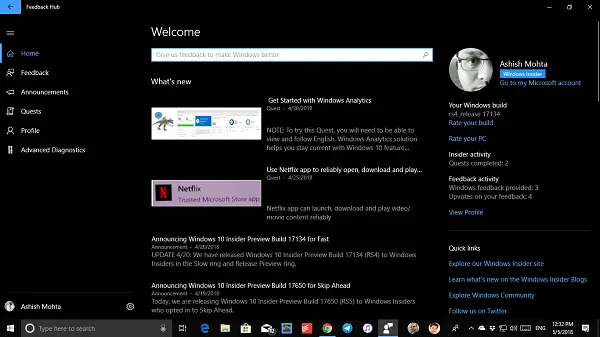
Features:
- Allows you to upvote if you find similar feedback or reports.
- Attach Screenshots or recreated the problem to help the company and others know the real problem.
- A search box is available right away to find about your problem.
- Filters and sorting available to find new threads easily.
- Intro to collections. You may find your feedback merged into a collection of similar feedback.
- The Upvote option next to feedback entries so you can add your voice without needing to file duplicate feedback.
Send Diagnostic Data to Microsoft
Feedback Hub allows you to send full feedback if you choose to send your diagnostic information which will help diagnose problems on your device. To enable this, follow the steps below:
- In the Feedback Hub, look for a gear icon. Its the Settings icon.
- Under the Diagnostics section, tick the following:
- Save a local copy of diagnostics created when giving Feedback.
- Save a local copy of Windows Errors.
- Show Advanced Diagnostic Feedback.
More on Microsoft Diagnostics here.
Send feedback to Microsoft about Windows 10
Search for Feedback Hub in your App list, and launch it. Once the app loads up, you will have to sign-in with a Microsoft account. We would suggest using the same account which you are using on your PC.
Post this, you should see a brilliantly organized Feedback section with all FeedBack listed in one place, and your feedback section to hold all your feedback. Now, let’s add a Feedback.
- Look for Add New Feedback button (blue colored).
- In the next screen, you will have to fill in details about the Feedback. Feedback can be a suggestion or a problem.
- Add brief or exhaustive details about it.
- Next select category, and subcategory. So if you select apps, you will get a list of possible apps to choose.
- The next thing feedback hub will ask you is a Screenshot or attach file for reference or Recreated the Problem.
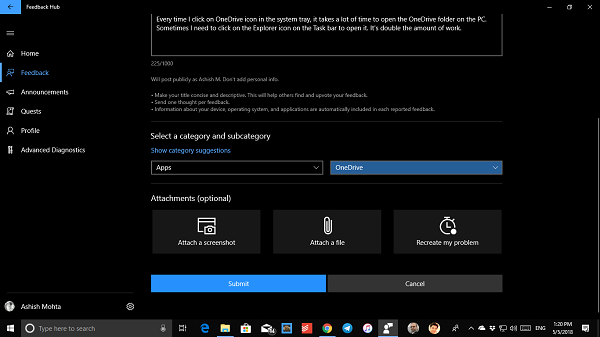
- While screenshots, and attaching file is very simple, Recreating a problem is an interesting option. It will ask you to redo the steps and record the whole event.
- Once complete, submit the feedback.
How to recreate your problem in Windows 10 using Feedback Hub
When you clock on Record my suggestion/ recreated my problem, it will ask you to share diagnostic data of that particular app, and also include screenshots of each step.
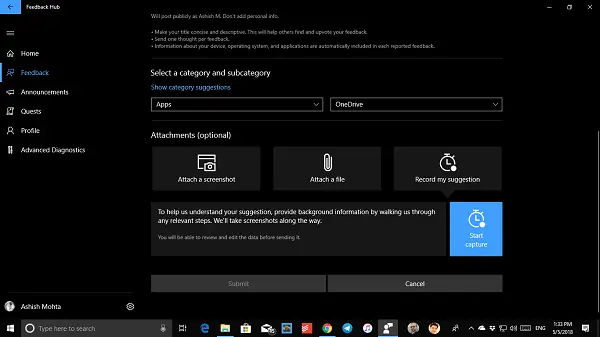
When it starts recording, it will turn red, and with every mouse click, you will see a red dot. This gives you an idea when the screenshot is being taken. Click on the Stop Capture button when you are done.
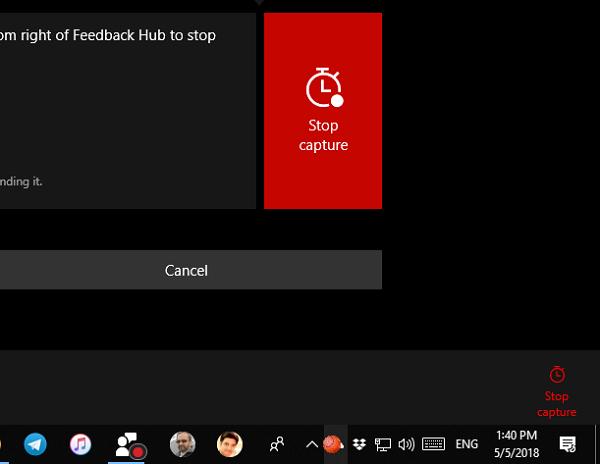
Post recording, you get to see and analyze what has been captured before you finally send it to the team. You can remove it if you have accidentally sent any sensitive data, and start over.
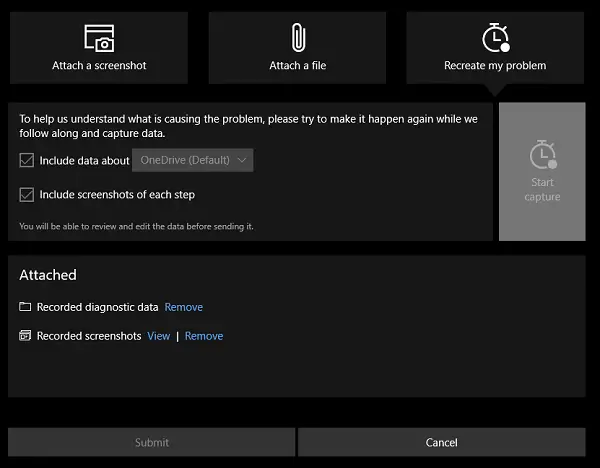
Click Submit, and you are done!
Read: How to give feedback to Microsoft for Office programs.
Find if your problem has been reported already, and upvote
The chances are high that your problem has been already reported by someone. It’s always a good idea to search for your problem or suggestion before creating a new one. Even if you report it again, Microsoft moderators will merge it with an existing report which also has been upvoted by many others.
- Open Feedback Hub, and in the search box, type your problem or suggestions and hit return.
- In the search results, look for feedback similar to yours.
- You can use the sorting tools to filter, and for best results, make your query specific, and the same as you had faced it. The more specific your search query, the better chance you’ll have of displaying feedback like yours.
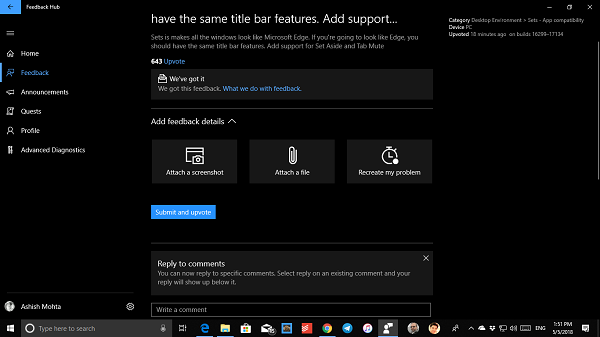
- If you find the exact one, upvote it, and add your data as well to help those who are looking at it. During your reply, you can also add a screenshot, attach file and also recreate the problem, along with your text.
In my opinion, it’s the best tool on Windows 10 for troubleshooting your problems and reporting them instantly.
More and more users should use it to send it directly and look for problems that have been faced by others.
Read: How to send Feedback or Complain about Windows 11 to Microsoft.
Report Windows 10 Activation errors
If your Windows 10 is genuine, but you still receive errors relating to a non-genuine software, you can follow up by using the steps below.
- Open Administrator command prompt then paste the code below and hit enter
Licensingdiag.exe -report %userprofile%\desktop\report.txt -log %userprofile%\desktop\repfiles.cab
- Copy the result and upload to One Drive, then locate the txt file Windows created on your desktop then upload both to One Drive
- Go to the Microsoft Product Activation Call Center and lay your report.
Let us know if this helped you to figure out if the Windows 10 key is genuine or not.
Read next: How to report bug, issue or vulnerability to Microsoft.
Feedback Hub is a piece of crap. Crashes all the time, whenever I have a serious problem to report. Not that Microsoft gives a crap anyway.